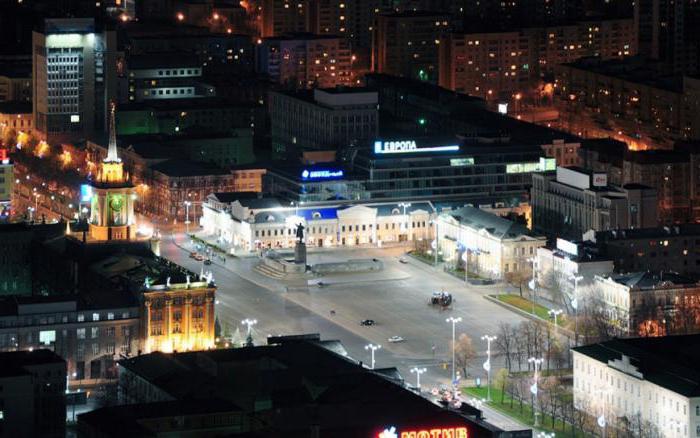From time immemorial, such a tradition has developed that at the same time with the foundation of the city, a place for a square was necessarily allocated in it. This rule applied to large and small urban settlements. Yekaterinburg Square was no exception.
Value
After all, the area played an important role in the life of city residents. This is not only a trading platform. It has traditionally remained the venue for a variety of events, such as litigation and the organization of fairs. In an era of lack of media, citizens came here to get the latest news, and municipal authorities announced official information.
The main square of Yekaterinburg with the name "Area of 1905" is no exception. But in the mouths of local residents, it sounds no more than just a “square”.
History: The Beginning
All the vicissitudes that took place in the history of Russia, to a certain extent, influenced the transformation of the area.
Due to the fact that initially this territory was mainly used as a large retail outlet, it was natural for Yekaterinburg residents to be the Market Square. This name existed until the mid-18th century. A significant event in the history of the city contributed to its renaming.
A very old building of the Catherine Church was demolished and a wooden Epiphany church was built. From now on, the square became Church. Nearly a quarter of a century later, and near it was laid a stone Epiphany Cathedral. Since the 30s of the 19th century it is a cathedral. This event was the reason for a new renaming. Noble merchants - Shabalin, Saveliev, Korobkov - acquired rich mansions near the square. In the 50s of the 19th century, a gymnasium was built for the stronger sex. The area of Yekaterinburg changed along with the history of the city.
History of the square in 1902
Over time, the Old Gostiny Dvor appeared in its southern part, and the square itself acquired a civilized European appearance - it is completely paved with paving stones, along which citizens and visitors have the opportunity to walk today.
And 1902 turned out to be sad for Gostiny Dvor - a fire occurred on its territory. But, as the Russian proverb says, there is no silver lining. The surviving premises did not begin to be restored, but they built the New Gostiny Dvor, but it is already two-story.
Place of rallies
The first revolution in Russia in 1905 did not pass Yekaterinburg, or rather, its area.
Almost 11 years - from 1906 until the revolution of 1917 - near the Cathedral there was a monument to the emperor-liberator Alexander II. The fact that this king abolished the shameful serfdom was not properly appreciated by the revolutionary soldiers. He suffered the fate of all the monuments that were related to tsarism.
In March 1917, the square of the city of Yekaterinburg became the venue for the rally in support of the February Revolution, and a little more than a month later - the May manifestation.
Transformations after the February Revolution of 1917
For a pedestal, which remained after the demolition of the monument to Alexander II in 1917, for a long time they could not find use. For almost two years - from 1918 to 1920 - there was a statue of Liberty on it, then the bust of Karl Marx stood for some two or three months in 1920, after which in May 1920 a monument with the symbolic name “Emancipation of Labor” was piled on a pedestal. S.D. Erzi worked on the sculpture. But the demonstration of the monument took place six years later. According to the sculptor, the symbol of the liberated work was to become a naked man, wrapped in chains, which he tried to break. Apparently, not all citizens liked this idea. The area of Yekaterinburg sought to decorate with other buildings.

The point in the epic with monuments and a marble pedestal was put in 1930 - the structure was completely dismantled. The Cathedral of the Epiphany Cathedral suffered the same sad fate, since what it personified contradicted the ideology of Marxism-Leninism. The following facts testify to the greatness of the cathedral: height, including a spire - 66 meters; the maximum number of parishioners that accommodated the room is 4.5 thousand. The idea of rebuilding the historic temple has not lost its strength today.
In 1930, a granite stand was built on the site of the dismantled pedestal with the cathedral building. During the festive parades dedicated to the achievements of the revolution and Soviet power, the party leaders on it watched the convoys of workers and the military. In 1957, the square of Yekaterinburg was decorated with a monument to the leader of the proletariat V.I. Lenin.
Modern name
However, the period of the late 1920s and early 1930s was marked not only by the destruction of the monuments of the Russian Empire that sunk into the summer. Two tram lines appeared, and three more were built over the existing two floors of the New Gostiny Dvor. From 1947 to 1954, through the efforts of the architect G.A. Golubev, the building has substantially changed, including the facade underwent major reconstruction; towers with a gilded surface of the spire were erected, a chime of chimes was heard from the inside; gypsum figures were placed on the roof around the perimeter .
Thanks to the metro station built in 1994 with the same name “Area 1905” (Yekaterinburg), visiting the square became more comfortable. In memory of the revolutionary events of 1905, a modern name was assigned to it. Yekaterinburg is developing every year. The camera (“Square of 1905” with its help can be seen from any corner of the country and not only) allows you to prevent riots and unpleasant incidents.